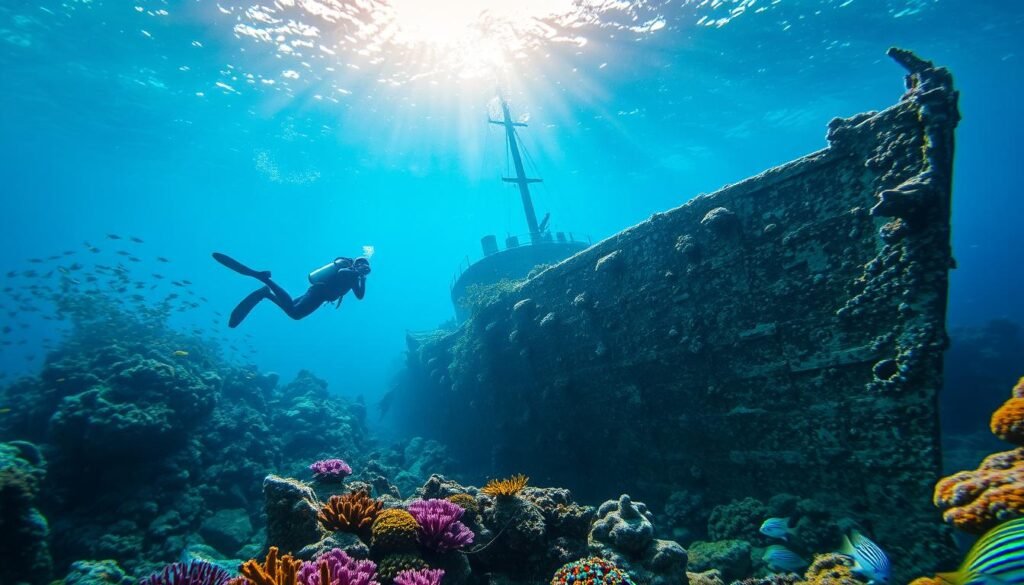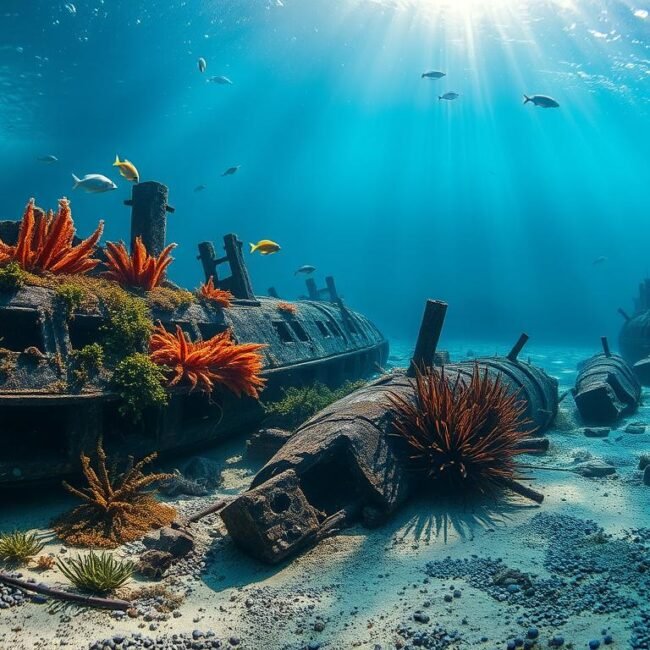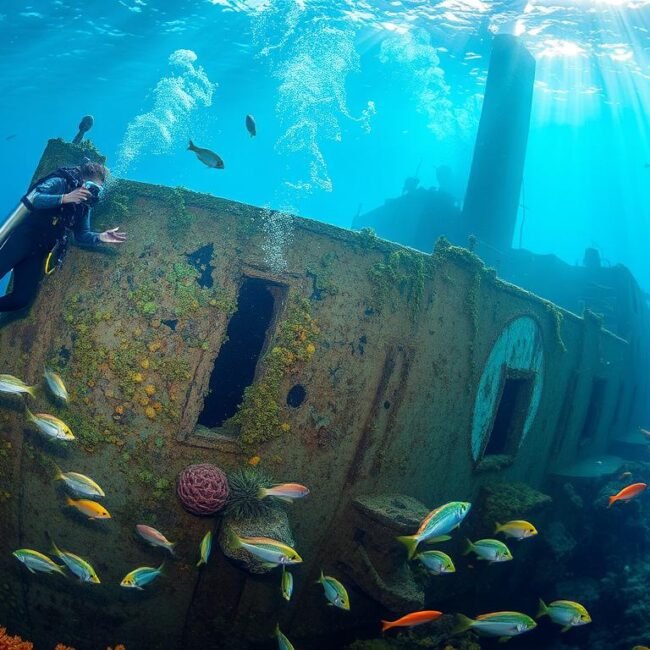Did you know the Red Sea has over 130 shipwrecks? These wrecks span centuries of history. They make the Red Sea a top spot for scuba diving.
I love exploring the underwater world. The Red Sea’s shipwrecks are amazing for all divers. They show us history and incredible marine life.
These wrecks tell stories of World War II and ancient trade. Each dive is like uncovering a new chapter. You’ll see how marine life adapts and the tales of ships at rest.
Key Takeaways
- Red Sea hosts over 130 documented shipwrecks
- Diving sites range from historical to modern maritime artifacts
- Suitable for divers with various experience levels
- Rich marine biodiversity surrounds underwater wrecks
- Offers unique underwater photography opportunities
- Combines historical exploration with marine ecosystem insights
Understanding the Red Sea’s Underwater Museum
The Red Sea is a treasure trove for underwater archaeology and maritime history. It lies between Africa and Asia. Here, divers can see the history preserved under its clear waters.
Historical Significance of Red Sea Shipwrecks
Red Sea shipwrecks are more than just sunken ships. They are time capsules that show centuries of maritime trade, naval battles, and exploration. Each wreck has its own story of culture, technology, and human strength.
- Merchant vessels from ancient trade routes
- Military ships from different historical periods
- Cargo vessels carrying exotic goods
Marine Life Around Wreck Sites
Shipwrecks become vibrant marine ecosystems, turning into artificial reefs. These reefs support diverse coral reef environments. They provide homes for marine creatures, enabling complex interactions.
| Marine Species | Typical Habitat | Ecological Role |
|---|---|---|
| Groupers | Wreck interior | Predatory fish |
| Lionfish | Wreck crevices | Invasive species |
| Coral Formations | Wreck exterior | Ecosystem builders |
Environmental Conditions for Diving
The Red Sea’s conditions make it perfect for underwater exploration. Its clear waters, stable temperatures, and calm currents are ideal for diving. This attracts both marine enthusiasts and underwater archaeologists.
“Underwater archaeology is not just about discovering artifacts, but understanding the stories these submerged landscapes tell.” – Marine Research Institute
Essential Requirements for Red Sea Wreck Diving
Exploring Red Sea wrecks requires special scuba certification and advanced diving skills. Divers must prepare well to safely navigate these underwater environments.
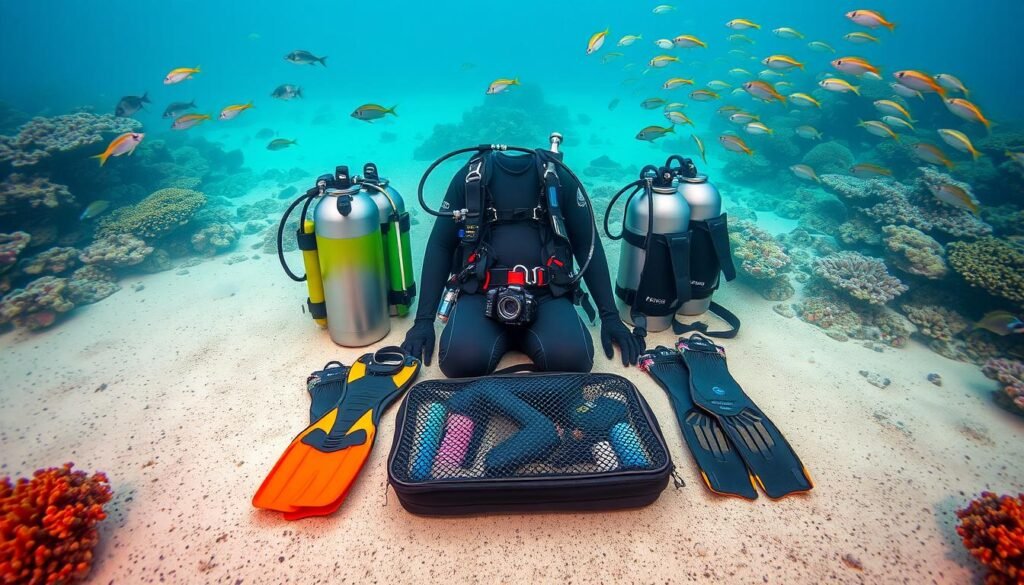
Divers need specific qualifications and gear for Red Sea wreck diving. Advanced certifications are key for handling complex underwater situations.
- Advanced Open Water certification minimum requirement
- Wreck diving specialty certification recommended
- Minimum of 50 logged dive hours
- Technical diving skills for deep wreck exploration
For wreck diving, you’ll need specialized gear for tough underwater conditions:
| Equipment Category | Recommended Gear | Purpose |
|---|---|---|
| Buoyancy Control | Technical BCD with additional D-rings | Improved maneuverability in confined spaces |
| Illumination | Primary and backup dive lights | Navigation through dark wreck interiors |
| Safety | Redundant air systems | Emergency breathing protection |
“Wreck diving requires not just equipment, but underwater expertise and respect for maritime history.” – Professional Diving Instructor
Before diving into Red Sea wrecks, invest in good training and quality gear. Proper preparation is key for a safe and memorable dive.
Best Seasons for Wreck Diving in the Red Sea
Planning a wreck diving trip to the Red Sea needs careful thought. The dive season here is perfect for exploring historic sites underwater. It’s a chance to see the beauty of the sea.
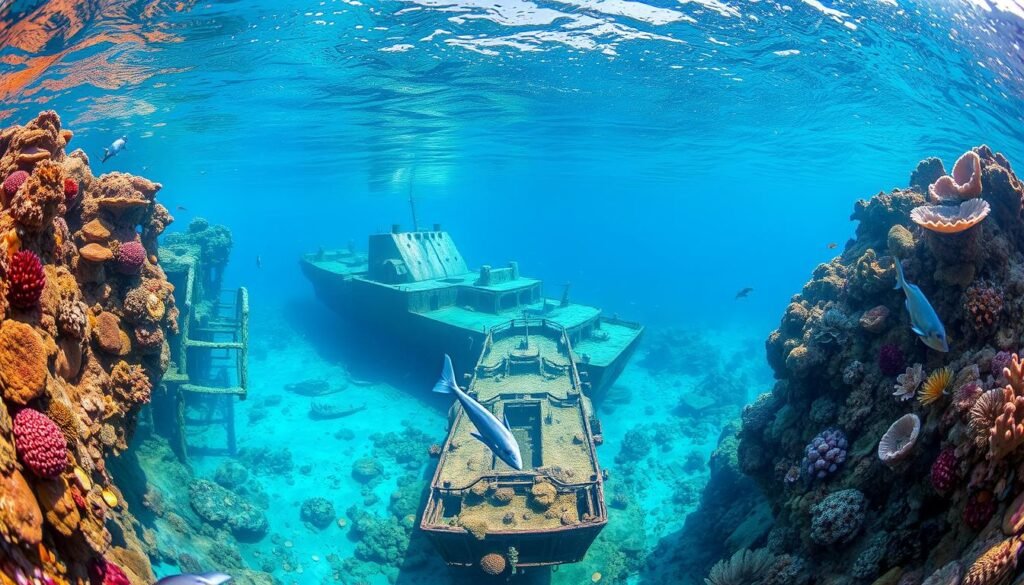
The Red Sea’s climate is great for diving most of the year. Knowing the seasons helps plan the best underwater adventure.
Peak Diving Months
My top pick for diving is from March to November. Each month offers a unique experience. Summer (June to August) is the best time for:
- Warm water
- Long days
- Calm seas
Weather Patterns and Visibility
The Red Sea’s water is incredibly clear. In peak months, you can see:
- Up to 30-40 meters underwater
- Little water movement
- Clear marine life
“The Red Sea offers some of the most consistent and breathtaking diving conditions in the world.” – Professional Diving Magazine
Water Temperature Variations
Water temperatures change with the seasons. This creates different diving experiences:
| Season | Water Temperature | Recommended Wetsuit |
|---|---|---|
| Summer | 26-30°C | 3mm shorty |
| Winter | 22-25°C | 5mm full wetsuit |
Understanding these changes helps divers make the most of their Red Sea wreck diving. It ensures unforgettable moments underwater.
The SS Thistlegorm: World War II Legacy
The SS Thistlegorm lies deep in the Red Sea, a time capsule from World War II. This British ship tells a story of war and the sea. It was sunk by German bombers in 1941 and is now a famous dive site.
“The SS Thistlegorm is more than a shipwreck – it’s a frozen moment of historical drama beneath the waves.” – Maritime Historians
The ship’s cargo shows the war effort’s strength. Divers find amazing artifacts like:
- Motorcycles and trucks
- Military boots and equipment
- Railway locomotives
- Ammunition and weapons
Diving the SS Thistlegorm is a unique experience. It’s 30 meters deep, perfect for skilled divers. Exploring inside, you feel like you’ve traveled back in time.
| Dive Specifications | Details |
|---|---|
| Location | Strait of Gubal, Red Sea |
| Depth | 30 meters |
| Dive Difficulty | Intermediate to Advanced |
| Best Season | October to May |
Photographers love the SS Thistlegorm. The well-preserved military gear and marine life make for incredible photos. It’s a chance to capture a piece of history underwater.
Wreck Diving in the Red Sea: Complete Guide to Popular Sites
The Red Sea is a treasure trove for wreck diving. As an experienced diver, I’ve seen many Red Sea wreck sites. They offer unique dives for all skill levels.
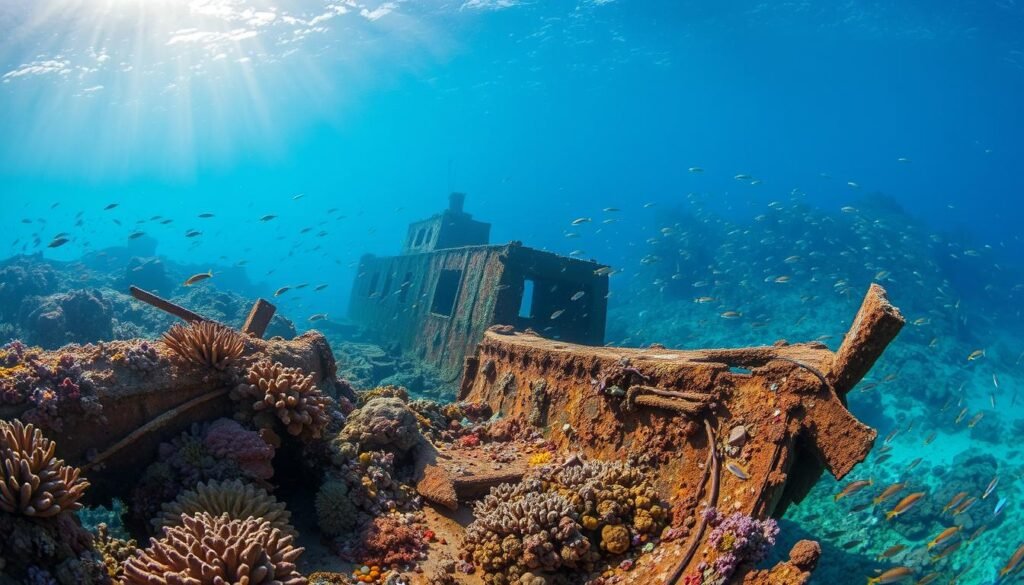
Diving in the Red Sea lets you explore history underwater. You’ll find wrecks from shallow reefs to deep dives. These challenges test even the most seasoned divers.
Northern Red Sea Wrecks
The northern part of the Red Sea is home to famous wrecks. Some key sites include:
- SS Thistlegorm: A World War II cargo ship
- Dunraven: A Victorian-era steamship
- Giannis D: A Greek freighter near Abu Nuhas reef
Southern Red Sea Wrecks
The southern Red Sea has more challenging and less-known wrecks. You can dive:
- Umbria: An Italian cargo vessel near Sudan
- Blue Belt wreck: A deeper technical diving site
- Million Hope: A cargo ship with complex underwater terrain
Technical Diving Opportunities
Technical diving in the Red Sea needs advanced skills and gear. Deeper wrecks require precise navigation and decompression. Divers should have:
- Advanced open water certification
- Extensive deep diving experience
- Specialized technical diving training
“The Red Sea’s wrecks are underwater museums waiting to be explored by skilled divers.” – Maritime Exploration Magazine
Each wreck has its own story. Divers get to dive into history and see the Red Sea’s amazing underwater world.
Salem Express: A Modern Maritime Tragedy
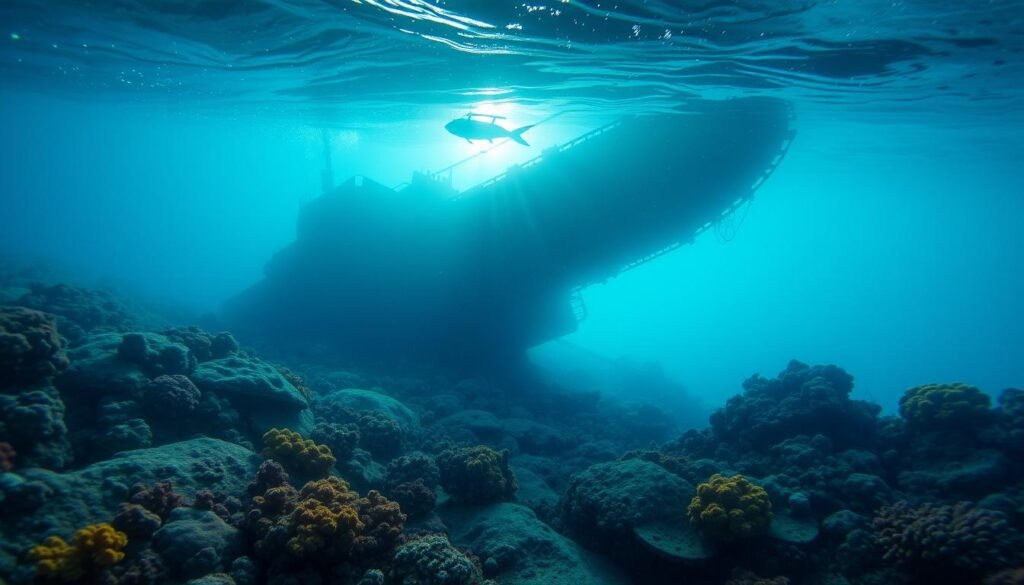
The Salem Express is a sad chapter in Red Sea maritime disasters. It sank on December 17, 1991, near Safaga, Egypt. This event left a lasting impact on maritime history and created a solemn underwater memorial.
The ferry faced harsh weather on its last trip. It hit a reef and sank fast, causing a huge loss of life. About 470 passengers lost their lives in this tragic event.
“The sea remembers what humans sometimes forget” – Anonymous maritime historian
Efforts to preserve the wreck have made it a key underwater archaeological site. Divers visiting this site must honor its history and treat it as a grave.
- Location: Near Safaga, Red Sea, Egypt
- Depth: 30-36 meters
- Sinking Date: December 17, 1991
- Estimated Casualties: 470 passengers
The wreck is a powerful reminder of the importance of maritime safety. Diving here requires respect, skill, and emotional awareness.
For careful divers, visiting this site is a chance to think about human weakness and the sea’s power.
The Dunraven: Victorian Era Mystery
The Dunraven shipwreck is a key part of Victorian maritime history. It offers divers a peek into the 19th-century sailing world. Located in the Red Sea, it’s a unique dive that takes you back to sailing’s golden age.
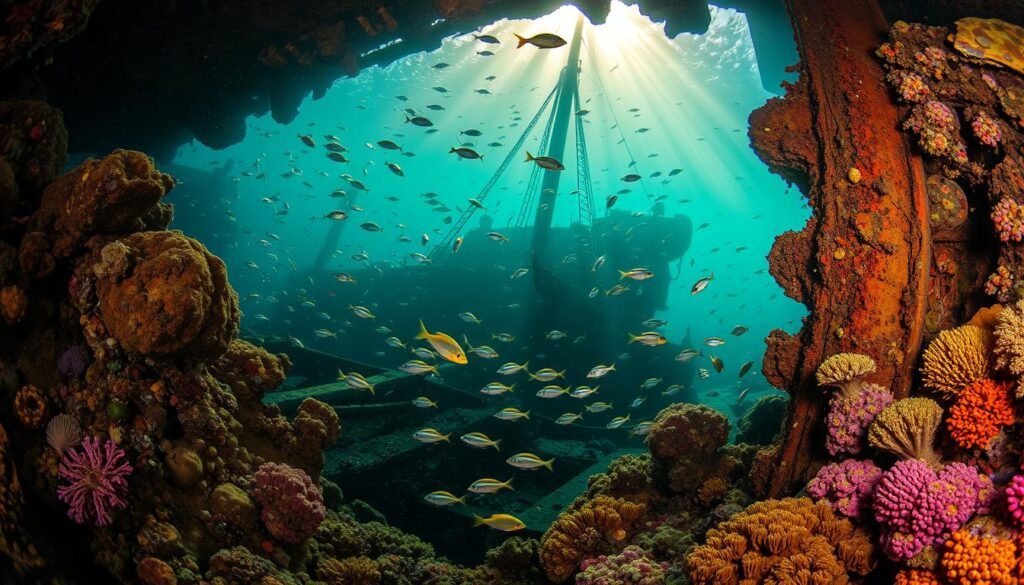
History and Discovery
The Dunraven sank in 1876 near Sha’ab Mahmoud. It’s a story of Victorian maritime challenges. The British ship hit a reef and sank, creating an underwater time capsule for today’s explorers.
Exploring the wreck means navigating through its old structure. You’ll see the details of 19th-century shipbuilding.
What to See Inside the Wreck
- Intact cargo hold with preserved artifacts
- Remnants of original wooden decking
- Steam engine components
- Marine life colonization throughout the wreck
Photography Tips
Photographing the Dunraven needs special underwater techniques. Use wide-angle lenses to show the wreck’s size. Bring strong underwater lights to light up the details in dark spots.
| Photography Recommendation | Technical Details |
|---|---|
| Lens Type | Wide-angle (16-35mm) |
| Lighting | Powerful external strobe lights |
| Camera Settings | Low ISO, fast shutter speed |
“The Dunraven is not just a shipwreck, but a submerged museum of Victorian maritime engineering.” – Underwater Exploration Magazine
Safety Protocols and Dive Planning
Wreck diving in the Red Sea needs careful safety planning. Professional divers know that safety comes first. They plan every dive with emergency procedures in mind. Exploring underwater wrecks can be risky, so they prepare well.
Important safety tips for wreck diving include:
- Check your gear before diving
- Get trained for wreck diving
- Learn about decompression
- Plan your dive with backup plans
“Preparation is the foundation of safe diving. Know your limits and respect the underwater environment.” – Red Sea Diving Expert
Emergency procedures are key for divers. They need to know how to handle challenges like bad visibility and getting stuck. Special courses teach them how to dive safely around wrecks.
Managing decompression is also vital. Divers must plan their dive carefully. They use dive computers and get trained to avoid risks at depth.
- Always dive within your skill level
- Keep your certifications up to date
- Use extra safety gear
- Talk clearly with your dive team
Wreck diving in the Red Sea is a mix of skill, preparation, and respect. By focusing on safety and planning, divers can explore these underwater sites safely.
Photography Tips for Wreck Documentation
Underwater photography of shipwrecks needs special skills. The Red Sea is full of historical treasures for photographers to capture. These images tell the story of the sea’s past.
Getting good at documenting wrecks takes preparation and skill. I’ll share tips to help you take amazing photos of underwater historical sites.
Essential Camera Gear for Underwater Exploration
Choosing the right camera gear is key for underwater photos. Here’s what I suggest:
- Waterproof digital SLR cameras with manual settings
- Wide-angle lenses for big wreck scenes
- Robust underwater housing to keep gear safe
- Multiple external strobe lights for better light
Advanced Lighting Techniques
Shipwrecks are dark, so you need smart lighting. Use several strobe lights at different angles. This removes shadows and shows off details.
“Great underwater photography is about understanding light and shadow underwater” – Professional Marine Photographer
Composition and Framing Guidelines
Good wreck photos are more than just tech. Here are some tips for composition:
- Use divers or sea creatures for size reference
- Look for unique parts of the wreck
- Try different camera angles
- Focus on telling a story of the sea’s history
By using these techniques, photographers can make wreck photos that tell a story. This helps keep the sea’s history alive.
Local Regulations and Dive Operators
Exploring the Red Sea’s wreck diving sites needs you to know the local rules and pick the best dive centers. Dive permits are key to seeing the underwater wonders of this marine paradise.
When you plan your wreck diving trip, you must think about a few important things:
- Mandatory dive permits for certain wreck sites
- Certification needs for different wreck diving levels
- Rules to protect the environment
- Safety rules for Red Sea liveaboards
Red Sea liveaboards are great for diving at many wreck sites. Top dive centers in the area offer full packages that include:
- Expert guides with deep local knowledge
- Top-notch diving gear
- Safety talks and orientation
- Special wreck diving training
The Red Sea’s dive rules protect both divers and marine life, making sure we can explore underwater safely.” – Marine Conservation Expert
I suggest looking into authorized dive operators who know the local rules well. They can make your diving experience smooth. Here’s a comparison of what to look for in a dive center:
| Criteria | Recommended Standard |
|---|---|
| Dive Permit Assistance | Full support and all the necessary documents |
| Safety Certifications | PADI, NAUI, or similar international certifications |
| Wreck Diving Expertise | Guides with deep knowledge of the historical sites |
| Equipment Quality | Modern, well-kept diving equipment |
Always check the latest rules before you go, as they can change. Working with trusted dive centers will make your Red Sea wreck diving trip safe and unforgettable.
Conclusion
Exploring the Red Sea’s wreck diving sites has shown us an amazing underwater world. These sunken ships are not just old relics; they are homes for many sea creatures. They also tell us about human history, making diving here a unique adventure.
It’s important to dive responsibly to keep these places safe. We must respect and carefully move around these sites. This way, we protect the history and the sea life that live there.
Diving in the Red Sea is more than just a fun activity. It connects us to the sea’s past, scientific discoveries, and the strength of marine life. Each wreck, like the SS Thistlegorm, has its own story, inviting us to join in the journey of exploration.
These dives remind us of the importance of balancing human history with marine life. By diving with care, curiosity, and a focus on conservation, we help keep these sites for others to enjoy in the future.
FAQ
What certifications do I need for wreck diving in the Red Sea?
For safe wreck diving in the Red Sea, you’ll need an Advanced Open Water certification. You should also get a Wreck Diving certification. Some sites, like the SS Thistlegorm, might need more technical diving skills.
When is the best season for wreck diving in the Red Sea?
The best time for wreck diving is from March to November. The best months are April to October. During these times, the water is warm, and visibility is great, making for the best dives.
Are there any safety concerns specific to Red Sea wreck diving?
Safety is key. Always control your buoyancy, use the right equipment, and follow local rules. Check the current and depth, and never dive beyond your skill level.
What marine life can I expect around Red Sea shipwrecks?
You’ll see a lot of marine life around wrecks. Expect to see coral, lionfish, scorpionfish, and glassfish. You might also see moray eels, barracuda, and reef sharks.
Do I need specialized equipment for wreck diving?
Yes, you’ll need dive lights, extra air, wreck reels, and cutting tools. Wear protective gear and use a dive computer for safe exploration.
How deep are most wreck dive sites in the Red Sea?
Depths vary. Recreational sites are 30 to 100 feet deep. Technical sites can go up to 130 feet or more. The SS Thistlegorm is about 100 feet deep, good for experienced divers.
Are there photography restrictions at wreck sites?
Photography is usually allowed, but be respectful. Some sites, like the Salem Express, have rules to protect their history and significance.
What are the water temperature variations in the Red Sea?
Temperatures range from 72°F in winter to 86°F in summer. Wear a 3mm wetsuit in summer and a 5mm suit in winter for comfort.
Do I need special insurance for wreck diving?
Yes, you need dive insurance that covers wreck diving. Standard travel insurance often doesn’t cover diving risks, so check your policy.
Can beginners participate in Red Sea wreck diving?
Some sites are okay for beginners, but many require advanced skills. Start with guided tours and courses, then build your experience before diving deeper.

